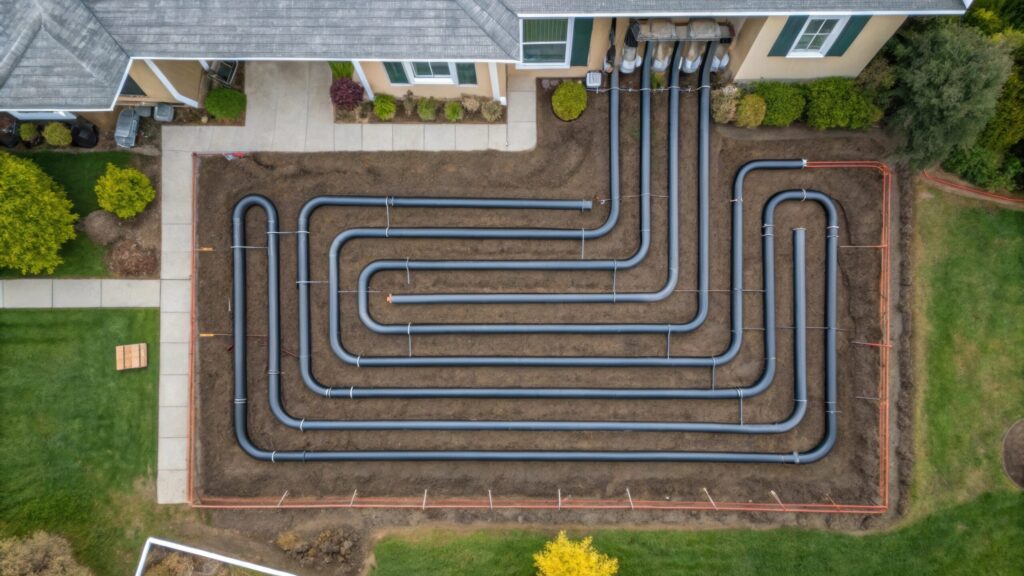If you’ve read our previous post on Indiana’s geothermal tax credits (https://absolutecomfort.org/geothermal-tax-credit-expiring/), you know the clock is ticking. The federal 30% Residential Clean Energy Credit is set to expire on December 31, 2025, thanks to the One Big Beautiful Bill Act (OBBBA) passed in July 2025. This means substantial savings—potentially thousands of dollars—are on the line for Hoosier homeowners looking to switch to an efficient, earth-powered heating and cooling system. Geothermal systems can slash your energy bills by up to 70% while providing reliable comfort in Indiana’s variable climate.
But how do you go from interest to installation? This guide breaks down the process step by step, helping you navigate everything from property assessment to post-installation perks. With fall approaching, now is the perfect time to start—avoid the rush and ensure your system is up and running before the deadline. Let’s dive in.
Step 1: Assessing Your Property’s Suitability
Before anything else, determine if a geothermal system is feasible for your home. These systems use ground-source heat pumps (GHPs) to transfer heat to and from the earth via underground loops. Indiana’s soil and climate are generally ideal, with consistent underground temperatures around 55°F year-round.
Key factors to consider:
- Yard Space: You’ll need room for horizontal loops (trenches 4-6 feet deep) or vertical loops (boreholes 100-500 feet deep). Horizontal setups work for larger lots, while vertical ones suit smaller urban properties in places like Carmel or Fishers.
- Soil Conditions: Sandy or loamy soils are best for heat transfer; rocky areas may increase drilling costs.
- Home Size and Insulation: A typical 2,000 sq ft home might require a 3-5 ton system.
Start by using online tools like ClimateMaster’s Geothermal Savings Calculator to estimate your potential energy savings—often 50-70% on heating and cooling bills. For a professional evaluation, schedule a site assessment with a certified installer. This usually takes 1-2 hours and costs $200-500, but it’s often credited toward installation.
Pro Tip: If you’re in a rural area, check for USDA Rural Energy for America Program grants, which can help offset costs for eligible properties.
Step 2: Choosing the Right Geothermal System
Once your property checks out, select a system that fits your needs. Most residential setups in Indiana are closed-loop GHPs, which circulate a water-antifreeze solution through buried pipes. These must be ENERGY STAR certified to qualify for incentives.
Options include:
- Horizontal Loops: Cheaper to install but require more land (about 1,500-2,000 sq ft per ton).
- Vertical Loops: Ideal for limited space, though drilling adds $5,000-10,000 to costs.
- Pond/Lake Loops: If you have access to a body of water, this can be the most efficient and least expensive option.
Upfront costs range from $10,000 to $30,000 for a full system, including loops, heat pump, and ductwork modifications. Factor in long-term savings: Systems last 25+ years for the indoor unit and 50+ for loops, far outpacing traditional HVAC.
Consult the Department of Energy’s guide for more on system types. Remember, the system must be new and installed in your primary or secondary residence to claim credits.
Step 3: Working with a Qualified Installer
Don’t go it alone—partner with an experienced, IGSHPA-certified installer like Absolute Comfort. During your consultation:
- They’ll perform a detailed heat load calculation using Manual J software.
- Provide a custom quote, timeline, and incentive breakdown.
- Discuss potential disruptions, like yard excavation (which is restored post-install).
With the 2025 deadline looming, book early to avoid supply chain delays. Installers are seeing a surge in demand, so aim to start consultations by early fall for a winter-ready system.
Step 4: Financing and Incentives
This is where the savings shine. The federal Residential Clean Energy Credit covers 30% of costs with no cap—claim it via IRS Form 5695 on your 2025 taxes. But act fast: Installation must be complete by December 31, 2025.
Indiana-specific perks include:
- Indiana Energy Saver Program : Up to $8,000 in rebates for low- to moderate-income households, launched in May 2025.
- Utility Rebates: Check providers like South Central Indiana REMC for $2,000 rebates on geothermal installs. Vectren (now CenterPoint Energy) and Citizens Gas may offer incentives for efficient systems. You can verify via DSIRE.
- Other Options: Low-income Hoosiers can access the Weatherization Assistance Program, which may cover geothermal upgrades.
Note: The state’s property tax deduction for geothermal was repealed effective January 1, 2025, but existing systems get a grace period until 2027.
Subtract rebates from your total cost before calculating the federal credit. Financing through green loans or PACE programs can make it more affordable.
Step 5: Installation Timeline and Process
Installation typically takes 1-2 weeks for a residential system, broken down as follows:
- Days 1-3: Site Prep and Loop Installation: Trenching or drilling for loops, followed by piping and backfilling.
- Days 4-7: Heat Pump Setup: Installing the indoor unit, connecting to your home’s ducts or radiant system, and wiring.
- Days 8-10: Testing and Commissioning: Flushing loops, pressure testing, and optimizing for efficiency.
Minimal disruption inside your home—most work is outdoors. For details, see the EPA’s geothermal overview.
Step 6: Post-Installation Benefits
Once operational, enjoy immediate perks: Lower bills, quieter operation, and a reduced carbon footprint. Many Indiana homeowners report ROI in 5-10 years, boosted by incentives. Systems increase home value by 5-10%.
Maintain with annual check-ups—loops are virtually maintenance-free. Share your story; we’ll feature real Hoosier testimonials in our next post!
Don’t Miss Out—Act Now!
With the federal credit vanishing after 2025, there’s no better time to go geothermal. Contact Absolute Comfort today for a free consultation: 📞 (765) 534-4328. We’ll help you beat the deadline and start saving.
Next in the series: “Real Stories: How Indiana Homeowners Are Saving Big with Geothermal Systems.”
Always consult a tax professional for personalized advice, as incentives evolve.

